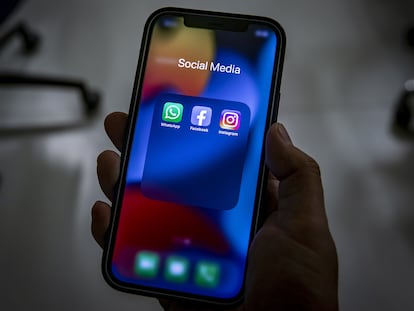‘Feeling sexy is a right’: why men are baring all on Instagram
Moderate nudity is in vogue on the social media platform. Some users seek to show off a sculpted physique, others to revindicate a non-normative silhouette. All are reaping passionate response and many, many likes


The arrival of summer not only floods social media with idyllic seaside sunsets, crystal-clear waters and images from those eager to share their beach reads. It also brings with it a barrage of photographs in which users flaunt their swimwear silhouettes. The most risqué of these shots are relegated to the green circle of “close friends”, meaning that they are relegated to being seen by only the specially-selected contacts determined by the user themselves. These are referred to as thirst traps, according to Urban Dictionary, which first debuted the phrase back in 2011 under the description, “A sexy photograph or suggestive message that people upload to social networks to let others know they are attractive.” The fact that they are referred to as “traps” is a nod to how the images are meant to be sexy, but not overtly sexual. After all, this is Instagram, an app that has firm rules when it comes to full-frontal nudity (buttocks are allowed, while female breasts are verboten.)
According to a study by the digital publication Mediapart in collaboration with the European Data Journalism Network and Algorithm Watch, men’s posts showing their exposed body are 28% more likely to appear in users’ feeds, with photographs that show landscapes or food having 60% less probability of being promoted by Instagram. Given this data, which suggests that the algorithm favors shots of us wearing less clothes, Facebook released a statement: “We position posts on the feed of each person according to the content and accounts in which they show interest, not according to factors as arbitrary as the presence of swimsuits.”
But as Fátima Martínez López, author of Influencer Marketing: Curso práctico para agencias, influencers y marcas (Influencer Marketing: A practical guide for agencies, influencers and brands; 2023, Anaya Multimedia) told EL PAÍS, “Since people are getting rich on OnlyFans, Instagram is becoming OnlyFans.” She says that though Instagram, like TikTok, has community standards that expressly prohibit certain content, over time, its moderators have become more relaxed. “Before, they would remove content, now they are more permissive and although there are limits on nudity and content, they don’t usually intervene if users don’t report it, because that type of content generates interactions and keeps users more hooked on their platforms. In the case of Twitter, sexual content is authorized and therefore, every day we see hundreds of porn accounts,” she says.
Still, as Doctor Carolina Are, innovation fellow at Northumbria University, explains to Mashable, not all bodies receive the same treatment on Instagram. “There have been stories that show that algorithms pick up, for instance, Black plus-size bodies more than white skinny bodies,” she says.
Alberto Velasco, the 40-year-old Spanish actor behind Mover Montañas (Moving Mountains), a theatrical production in which he speaks of folklore through the use of his own body that was awarded with the prize for Most Innovative at Valladolid’s International Festival of Theater and Street Arts, uploads endless images to his social media accounts in which nudity has practically become a political act. “In reality, the nude intimidates me. When people with non-normative bodies take our clothes off, we are not only removig clothes from our body, but also our soul. There’s a kind of vulnerability that has been exposed, because we are showing off our wounds. My thoughts are a dichotomy: it angers me that, because I uploaded a photo, people call me brave, but at the same time, I think I am, because I am aware that the act will have a positive repercussion among people with diverse bodies and who are tired of only one kind of body being represented,” he says.
“A fat person has to be demonstrating all the time that they no longer want to be one, that intimidates me,” says the actor, who confesses to having posted and deleted too many photos to count. He eventually does post some of them, he says, out of rebellion and to stake a claim on the territory of the normative. “Sexy photos that do not come from a normative body evoke shame. Even people who have a personal preference for non-normative bodies are implicated, which makes them feel bad. Being sexy is the right of everyone who forms a part of society, we all have a desire to be wanted. Sometimes there is a halo of rage, but I reclaim the power of my body from a place of happiness,” he says.
Velasco says that his social media has been seen by many people thanks to his projects. “More than 2000 people have found photos in which I am naked unacceptable. But many people, less in quantity, but who become more engaged, have also arrived through those images,” he tells EL PAÍS.
Validation and business
Likes and flame emojis function on social media as dopamine injections, the inspiration that drives many people to upload sexy images of themselves wearing little clothing. “Uploading those photos isn’t just a way of getting external validation, although I admit that it can be very gratifying. It’s also a form of personal liberation. I feel much freer now. The truth is that my boyfriend doesn’t care at all that I upload sexy photos to my close friends circle,” says David García, a 38-year-old computer scientist who starting posting thirst traps during the pandemic “out of sheer boredom.” “I’ve always been a bit shy with my body, but I started uploading these pictures out of curiosity and noticed, from the very beginning, that I got a lot of attention. I thought that the positive reception was due to the fact that people were, like me, locked up at home. But things stayed the same afterwards, when the pandemic ended. I really can’t complain. The number of flames and messages I get is overwhelming at times, but it’s also a sign that I’m connecting with my audience, which translates into subscriptions,” he says.
When David talks about subscriptions, he is referring to a feature introduced in 2022 that allows Instagram users to create an alternative, paid channel for offering exclusive content to followers, who pay a monthly fee set by the creator. The feature swaps out the green of “close friends” with a ring whose golden color implies certain privilege. Martínez López, founder of marketing and communication consultants Social Media Fidelity Management, says that, “Instagram subscriptions can easily become OnlyFans,” as many influencers take advantage of the Instagram feature to upload photos that are more intimate and sensual than what they would post on their public profile.
In a 2013 essay published by The New York Times, actor James Franco wrote of another reason why photographs of oneself work so well on social media: they get the attention of an increasingly elusive social milieu. “In this age of too much information at a click of a button, the power to attract viewers amid the sea of things to read and watch is power indeed,” Franco attested. And that can have a positive impact on one’s professional life. Andrés Manzano, a 31-year-old model, shares Franco’s view. “My shirtless photographs have way more likes than the rest. I think that, aside from the memory of the photograph, I like to show that I’ve worked on my body, and knowing that it can get more likes, that drives me to post photographs that also raise my self-esteem. I’m not going to deny that those photos aren’t bad for flirting…” says Manzano. “There are people who have told me that I look arrogant or full of myself from the photos I post, but I use it more like a portfolio for my work and to show my range. When I’ve had a girlfriend, she’s never gotten mad because of it. If someone did, I’d cut off the relationship immediately, it’s personal and everyone posts what they want.”
Martínez López says that sexy images and videos generate more attention. “Users are attracted by that kind of content, it gets more interaction in general, likes and comments more than anything. Although many comments can be negative, the algorithm doesn’t discriminate and based on the volume of engagement, it gives more relevancy to the post and makes it go viral,” she says. For now, the algorithm hasn’t been able to parse the most important factor behind sexy content: its intention. Is it supposed to be an arousing, validating, revindicating nude? Or can it be all things at once? As long as some bodies continue to appear more valuable than others, the debate remains open.
Sign up for our weekly newsletter to get more English-language news coverage from EL PAÍS USA Edition
Tu suscripción se está usando en otro dispositivo
¿Quieres añadir otro usuario a tu suscripción?
Si continúas leyendo en este dispositivo, no se podrá leer en el otro.
FlechaTu suscripción se está usando en otro dispositivo y solo puedes acceder a EL PAÍS desde un dispositivo a la vez.
Si quieres compartir tu cuenta, cambia tu suscripción a la modalidad Premium, así podrás añadir otro usuario. Cada uno accederá con su propia cuenta de email, lo que os permitirá personalizar vuestra experiencia en EL PAÍS.
¿Tienes una suscripción de empresa? Accede aquí para contratar más cuentas.
En el caso de no saber quién está usando tu cuenta, te recomendamos cambiar tu contraseña aquí.
Si decides continuar compartiendo tu cuenta, este mensaje se mostrará en tu dispositivo y en el de la otra persona que está usando tu cuenta de forma indefinida, afectando a tu experiencia de lectura. Puedes consultar aquí los términos y condiciones de la suscripción digital.
More information
Archived In
Últimas noticias
Most viewed
- Reinhard Genzel, Nobel laureate in physics: ‘One-minute videos will never give you the truth’
- Oona Chaplin: ‘I told James Cameron that I was living in a treehouse and starting a permaculture project with a friend’
- Pablo Escobar’s hippos: A serious environmental problem, 40 years on
- Why we lost the habit of sleeping in two segments and how that changed our sense of time
- Charles Dubouloz, mountaineering star, retires at 36 with a farewell tour inspired by Walter Bonatti










































